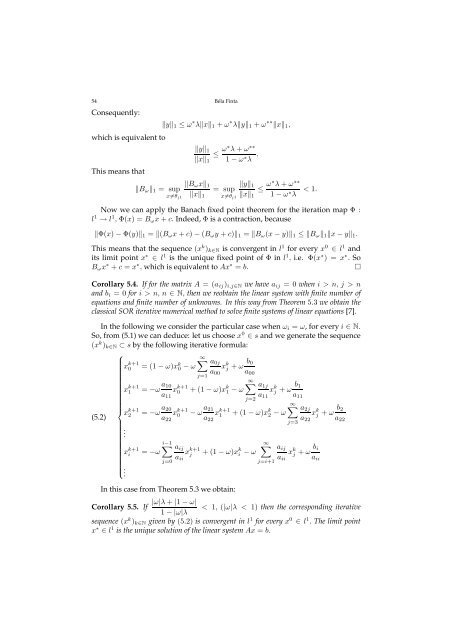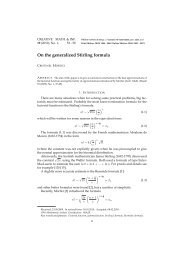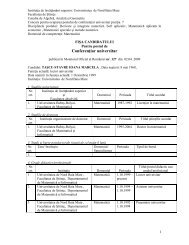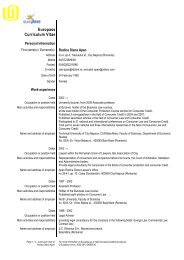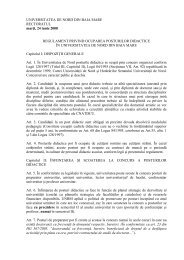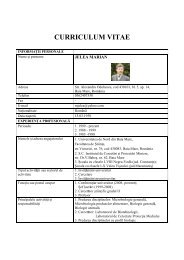54 Béla FintaConsequently:‖y‖ 1 ≤ ω ∗ λ‖x‖ 1 + ω ∗ λ‖y‖ 1 + ω ∗∗ ‖x‖ 1 ,which is equivalent to‖y‖ 1≤ ω∗ λ + ω ∗∗‖x‖ 1 1 − ω ∗ λ .This means that‖B ω x‖ 1 ‖y‖ 1‖B ω ‖ 1 = sup = sup ≤ ω∗ λ + ω ∗∗x≠θ l‖x‖1 1 x≠θ l‖x‖1 1 1 − ω ∗ λ < 1.Now we can apply the Banach fixed point theorem <strong>for</strong> the iteration map Φ:l 1 → l 1 , Φ(x) =B ω x + c. Indeed, Φ is a contraction, because‖Φ(x) − Φ(y)‖ 1 = ‖(B ω x + c) − (B ω y + c)‖ 1 = ‖B ω (x − y)‖ 1 ≤‖B ω ‖ 1 ‖x − y‖ 1 .This means that the sequence (x k ) k∈N is convergent in l 1 <strong>for</strong> every x 0 ∈ l 1 andits limit point x ∗ ∈ l 1 is the unique fixed point <strong>of</strong> Φ in l 1 , i.e. Φ(x ∗ )=x ∗ . SoB ω x ∗ + c = x ∗ , which is equivalent to Ax ∗ = b.□Corollary 5.4. If <strong>for</strong> the matrix A =(a ij ) i,j∈N we have a ij =0when i>n,j>nand b i =0<strong>for</strong> i>n,n∈ N, then we reobtain the <strong>linear</strong> system with finite number <strong>of</strong><strong>equations</strong> and finite number <strong>of</strong> unknowns. In this way from <strong>The</strong>orem 5.3 we obtain theclassical <strong>SOR</strong> iterative numerical <strong>method</strong> to solve finite <strong>systems</strong> <strong>of</strong> <strong>linear</strong> <strong>equations</strong> [7].In the following we consider the particular case when ω i = ω, <strong>for</strong> every i ∈ N.So, from (5.1) we can deduce: let us choose x 0 ∈ s and we generate the sequence(x k ) k∈N ⊂ s by the following iterative <strong>for</strong>mula:(5.2)⎧⎪⎨⎪⎩.∞ x k+10 =(1− ω)x k 0 − ω ∑ a 0jx k j + ω b 0a 00j=1x k+11 = −ω a 10a 11x k+10 +(1− ω)x k 1 − ωx k+12 = −ω a 20x k+10 − ω a 21x k+1a 22 a 22..x k+1i∑i−1= −ωj=0a 00∞∑a 1jx k j + ω b 1aj=2 11 a 11∞1 +(1− ω)x k 2 − ω ∑a ija iix k+1j +(1− ω)x k i − ω ∞ ∑In this case from <strong>The</strong>orem 5.3 we obtain:j=i+1j=3a ija iix k j + ω b ia iia 2ja 22x k j + ω b 2a 22|ω|λ + |1 − ω|Corollary 5.5. If < 1, (|ω|λ < 1) then the corresponding iterative1 −|ω|λsequence (x k ) k∈N given by (5.2) is convergent in l 1 <strong>for</strong> every x 0 ∈ l 1 . <strong>The</strong> limit pointx ∗ ∈ l 1 is the unique solution <strong>of</strong> the <strong>linear</strong> system Ax = b.
<strong>The</strong> <strong>SOR</strong> <strong>method</strong> <strong>for</strong> <strong>infinite</strong> <strong>systems</strong> <strong>of</strong> <strong>linear</strong> <strong>equations</strong> (<strong>III</strong>) 55In the following we consider the particular case, when ω i = ω =1<strong>for</strong> everyi ∈ N. So from (5.2) we can deduce: let us choose x 0 ∈ s and we generate thesequence (x k ) k∈N ⊂ s by the following iterative <strong>for</strong>mula:(5.3)⎧⎪⎨x k+10 = −∞∑j=1a 0ja 00x k j + b 0x k+11 = − a 10a 11x k+10 −a 00∞∑j=2x k+12 = − a 20a 22x k+10 − a 21a 22x k+1.x k+1i∑i−1a ij= − x k+1ja iij=0−a 1ja 11x k j + b 11 −∞∑j=i+1a 11∞∑j=3a 2ja 22x k j + b 2a 22a ija iix k j + b ia ii⎪⎩.From <strong>The</strong>orem 5.3 and Corollary 5.5 we obtain the author’s result, the Gauss-Seidel’s iterative <strong>method</strong> <strong>for</strong> <strong>infinite</strong> <strong>systems</strong> <strong>of</strong> <strong>linear</strong> <strong>equations</strong> [4]:Corollary 5.6. If λ< 1 2 , then the corresponding iterative sequence (xk ) k∈N given by(5.3) is convergent in l 1 <strong>for</strong> every x 0 ∈ l 1 . <strong>The</strong> limit point x ∗ ∈ l 1 is the unique solution<strong>of</strong> the <strong>linear</strong> system Ax = b.We can obtain similar results if we replace the space l 1 by the space l ∞ or l p ,<strong>for</strong> p ∈ (1, +∞).We mention that all these results are valid in the complex case, too.REFERENCES[1] Finta, B., A Remark about Vector and Operator Norms, Mathematical Magazine Octogon, Braşov, 6,No. 1, April, 1998, 58-60[2] Finta, B., A Remark about Vector and Matrix Norms (II), Buletin Ştiinţific, XV-XVI, Universitatea”Petru Maior”, Tg. Mureş, 2002-2003, 113-120[3] Finta, B., Jacobi’s <strong>The</strong>orem <strong>for</strong> Infinite System <strong>of</strong> Linear Equations, Pr<strong>of</strong>esor Gheorghe Fărcaşlavârsta de70 de ani, Volum omagial, Editura Universităţii ”Petru Maior” Tg. Mureş, 2004, 103-108[4] Finta, B., Gauss-Seidel’s <strong>The</strong>orem <strong>for</strong> Infinite System <strong>of</strong> Linear Equations (II), International Conference”European Integration Between Tradition and Modernity”, IETM First Edition, ”Petru Maior”University <strong>of</strong> Tg. Mures, 22-24 September 2005, Romania, 669-677[5] Horn, R. A., Johnson, C. R., Matrix Analysis, Cambridge University Press, Cambridge, 1990[6] Kantorovitch, L., Akilov, G., Analyse fonctionnelle, Éditions MIR, Moscou, 1981[7] Plato, R., Concise Numerical Mathematics, Graduate Studies in Mathematics, 57, AMS, 2003[8] Szidarovszky, F., Yakowitz, S., Principles and Procedures <strong>of</strong> Numerical Analysis, Plenum Press,New York and London, 1978DEPARTMENT OF MATHEMATICS”PETRU MAIOR”UNIVERSITY TG. MUREŞNICOLAE IORGA 1, 540088 TG. MUREŞ, ROMANIAE-mail address: fintab@upm.ro


